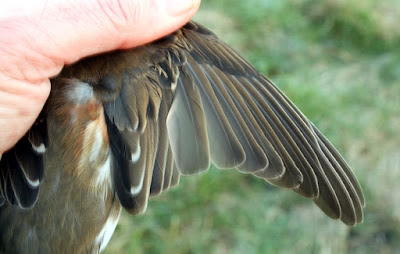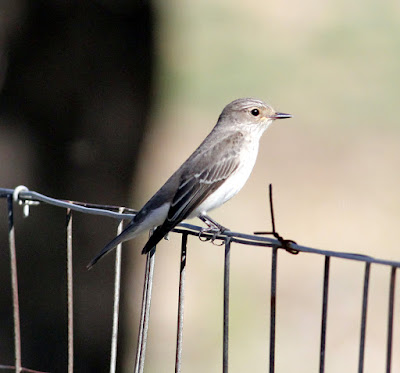The settled weather of late has meant a run of ringing sessions as opposed to the usual postponements due to wind, rain or very often both. I was on Granddad duties on Monday when Andy and Bryan caught another 50+ birds at Oakenclough. Their catch included another 20 Redwings, 7 “Continental” Blackbirds, 10 more Goldcrests and half a dozen Lesser Redpolls. They caught a Tree Sparrow too, a scarce species in the hills.
Tree Sparrow
That bumped up the total of birds ringed here in the last two weeks to almost 300, and all with a low number of recaptures which typifies the large throughput of autumn migration.
It looked like our good fortune was due to end but when the weather folk promised high pressure lingering into Tuesday morning I met up with Andy at 0700 for yet another ringing session.
With a good degree of cloud and a nagging north-westerly we didn’t hit the high spots but were happy enough with another 26 birds - 15 Redwing, 2 Blackbird, 2 Great Tit, 2 Blue Tit, 2 Goldcrest, 1 Coal Tit and 2 Chaffinch.
Redwing
Today we passed the 50 mark for autumn Redwings, a figure which included just a handful of adults, the majority being birds of the year. The adult below has tertial feathers with narrow creamy-white tips and broad tail feathers which are rounded at the end.
Redwing from "Svensson"
Adult Redwing
Visible migration was rather thin and unspectacular this morning, perhaps due to the amount of cloud coupled with the less than ideal north-westerly wind. Our 15 new Redwings came from approximately 200 that arrived in tiny groups of two or three birds or parties of 30/40 strong. Otherwise we saw no Fieldfares, a single Mistle Thrush and just a handful of Chaffinch.
The forecast of more changeable weather suggests that we’ll now get a day or two off ringing. That’s not to say there won’t be news, views and pictures on Another Bird Blog so log in soon for the latest.
Linking today to Stewart's World Bird Wednesday.
Linking today to Stewart's World Bird Wednesday.


































































.jpg)












